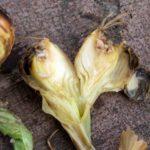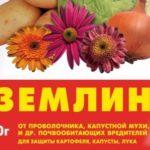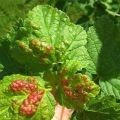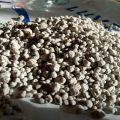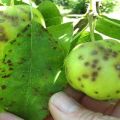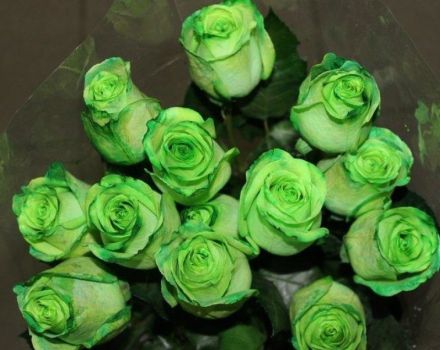Instructions for use and composition of Zemlin, storage conditions and analogues
"Zemlin" is an insecticide, which, according to the instructions for use, destroys soil-dwelling insects. The drug has an intestinal and contact effect, that is, it gets to pests through food and through direct contact. In plants or soil, it persists for 20 days. This time is enough to destroy insects that can destroy young seedlings. It is applied once, in spring, at the time of planting crops.
Composition and principle of action
"Zemlin" is an organophosphate insecticide familiar to many summer residents. It is a nerve poison that is used to control pests in the soil. The drug is available in the form of granules. "Zemlin" is packaged in plastic bags weighing 30 grams. The granules are applied to the soil in dry form, mixed with sand, sawdust or dissolved in water.
The active substance of the drug is diazinon (50 grams per 1 kilogram). It acts on insects by entering their body with food and through the skin. It is a chemical that has insecticidal properties. Diazinon acts on cholinesterase, that is, an enzyme that transmits nerve impulses. The poisonous substance has a neuroparalytic effect and leads to the death of pests. The duration of its activity is 2-3 weeks. Diazinon is completely detoxified after 20 days. Its toxic residues do not accumulate in plants.
"Zemlin" is introduced into the soil or scattered on the soil surface. The drug destroys soil pests. The active substance "Zemlin", getting into the soil, is absorbed by the root system and enters the seedlings of plants. In cultures, it lasts no more than 20 days. This time is enough to protect the plants, to give them the opportunity to grow, while simultaneously destroying the existing poisons of pests.
Appointment
Zemlin is used against gnawing and sucking pests. The drug destroys insects such as wireworms, weevils, fleas. With its help, you can get rid of aphids, scoops, ground beetles, cabbage and onion flies, bear, ants. The drug protects even indoor plants from soil flies and mosquitoes.
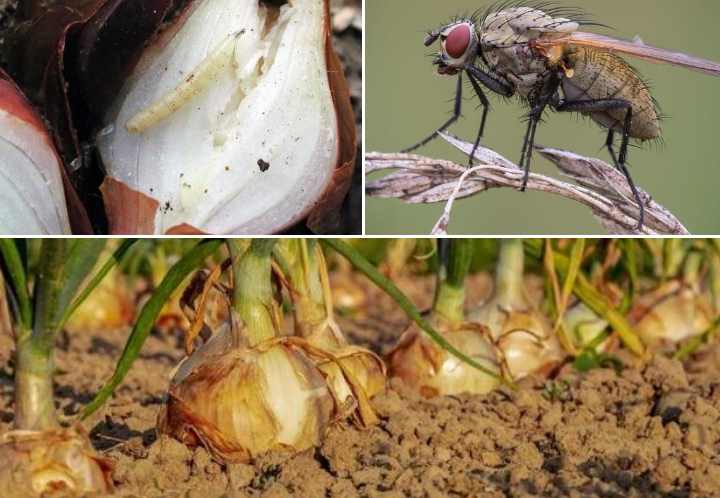
Advantages and disadvantages
Advantages of the drug "Zemlin":
- easy to use;
- does not accumulate in plants;
- disintegrates in the soil after 2-3 weeks;
- destroys simultaneously sucking and gnawing pests;
- acts by direct contact with insects and through plants.
Cons of using:
- seed and root treatment can lead to stunted plant growth;
- dangerous for bees (at the time of spraying);
- the granules or solution, if swallowed, causes poisoning in humans.
Compatibility with other products
The insecticide "Zemlin" is allowed to be used in conjunction with herbicides and fungicides. All drugs for pest control should be used no more than the recommended dose in the instructions.
Instructions for use
Zemlin consumption table for different crops:
| Consumption rate | Plant name | Pest
| Mode of application | Number of treatments (interval) |
| 30 g for 10-20 sq. m | onion | onion fly | tillage at the same time as planting bulbs | 1 time, but with a large number of insects 2 times with an interval of 60 days |
| 30 g for 10-30 sq. m | cabbage | cabbage fly | introduction into the ground simultaneously with planting seedlings | 1-2 times (interval 60 days) |
| 30 g for 10-20 sq. m | potatoes | wireworm | application to the soil when planting potatoes | 1-2 times (interval 60 days) |
| 30 g per 20 sq. m | flower plants | soil pests | application to the ground before planting | 1 time
|
"Zemlin" is introduced into the soil in spring, before or during planting. The drug is mixed with dry sand or sawdust (0.5 liters of sand and 1 packet of "Zemlin") and scattered on the ground. Granules can be used in pure form, that is, scattered over the surface of the soil.
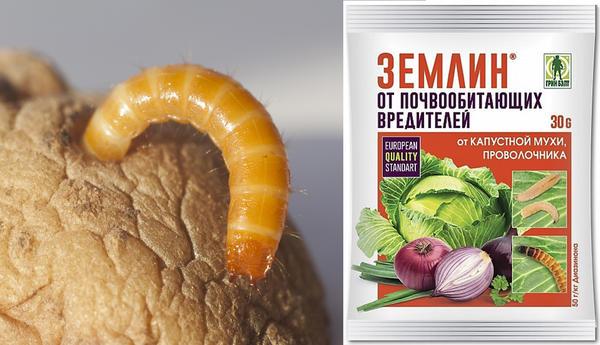
If there are many insects, a second treatment is carried out in the summer. "Zemlin" can be diluted with water (10 g per bucket of liquid) and water the soil near the plants. The diluted drug is allowed to irrigate crops, but no later than 60 days before harvesting. For prevention purposes, the insecticide in the form of granules can be used in the fall, after harvest.
Precautions
It is necessary to work with "Zemlyan" in a protective mask, glasses, rubber gloves. The toxic properties of the drug persist for 20 days after soil treatment. "Zemlin" belongs to the 3rd hazard class. If the plants are sprayed with an aqueous solution of the drug, then within 3-4 days the active substance can cause the death of bees. Granules applied to the ground are not harmful to beneficial insects.
First aid for poisoning
It is forbidden to take an aqueous solution of the drug inside. This poisonous substance in the form of granules should also not be consumed. If it enters the human body, "Zemlin" can cause poisoning.
When working with it, you must follow safety rules (wear a respirator, work in goggles, rubber gloves).
In case of poisoning, you need to drink a few glasses of warm water or a weak solution of soda and induce vomiting. It is recommended to take activated charcoal tablets and some laxative. In severe cases, it is advisable to seek medical attention or injections with atropine and similar drugs.

Terms and conditions of storage
The drug must be used within 2 years from the date of manufacture. The expiration date is usually indicated on the packaging. It is necessary to store Zemlin together with other chemical plant protection products, away from food, out of the reach of children.
Analogs
Besides Zemlin, you can buy other preparations containing diazinon. In personal subsidiary plots, they use such means of dealing with pests living in the ground: "Medvetoks", "Thunder", "Barguzin", "Medvegon", "Vallar", "Grizzly", "Provotox", "Muravyin", "Terradoks".
Reviews
Gardeners have long been using drugs with diazinon in their composition. Insecticide "Zemlin" has earned good reviews, as it effectively copes with insects living in the ground.
Anna Viktorovna, 52 years old: “I use Zemlin twice a year: in the spring, before planting, and in the fall, after the harvest. An excellent tool. "
Viktor Semenovich, summer resident: “They process potatoes with Zemlyan before planting. Saves from the wireworm and the Colorado potato beetle. "


